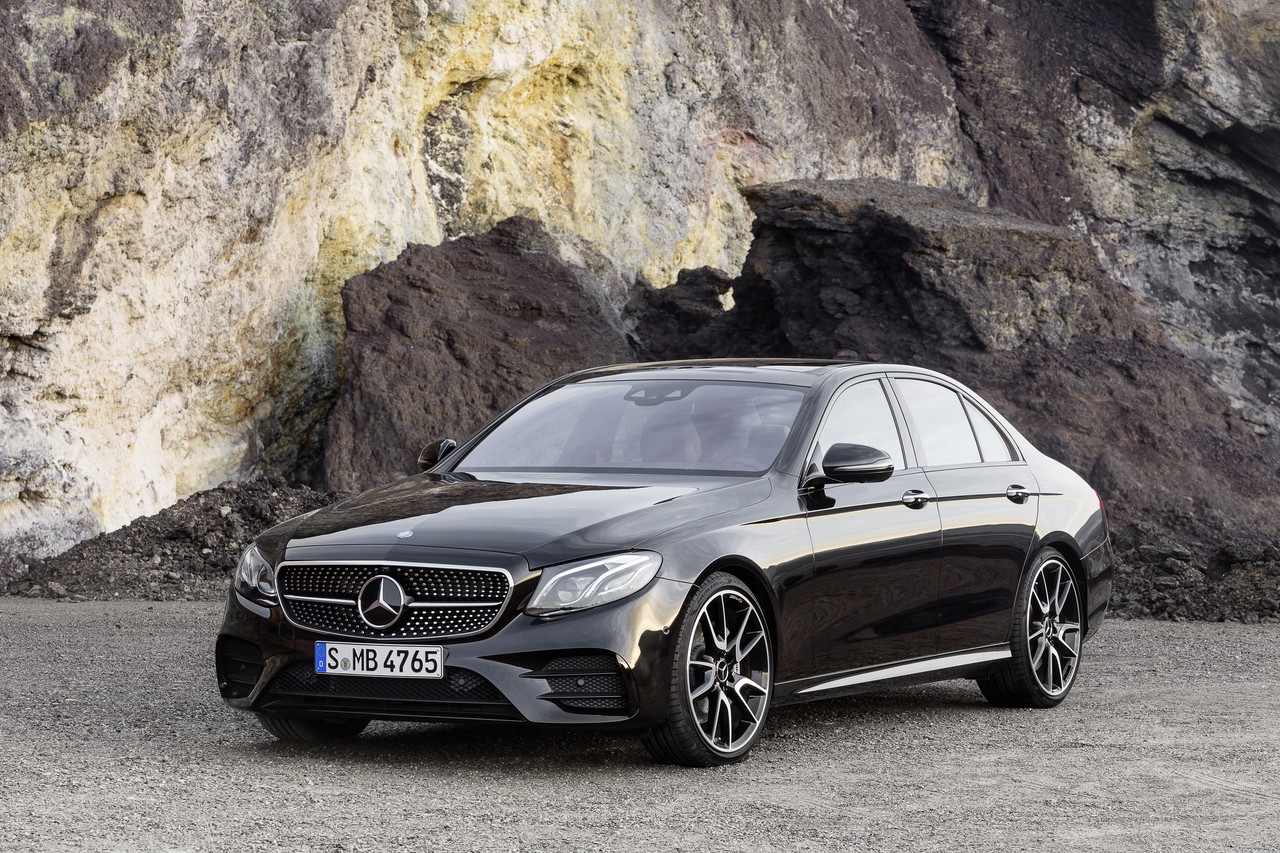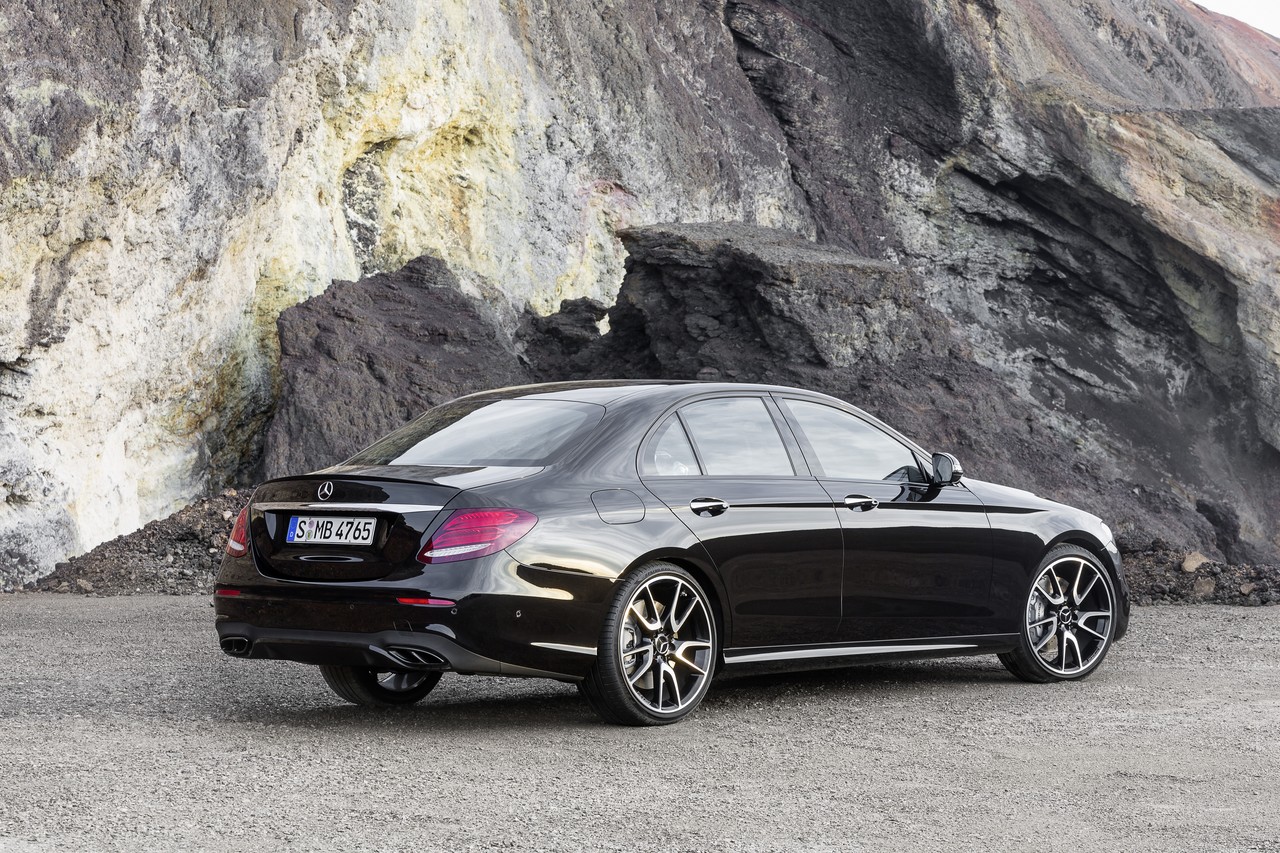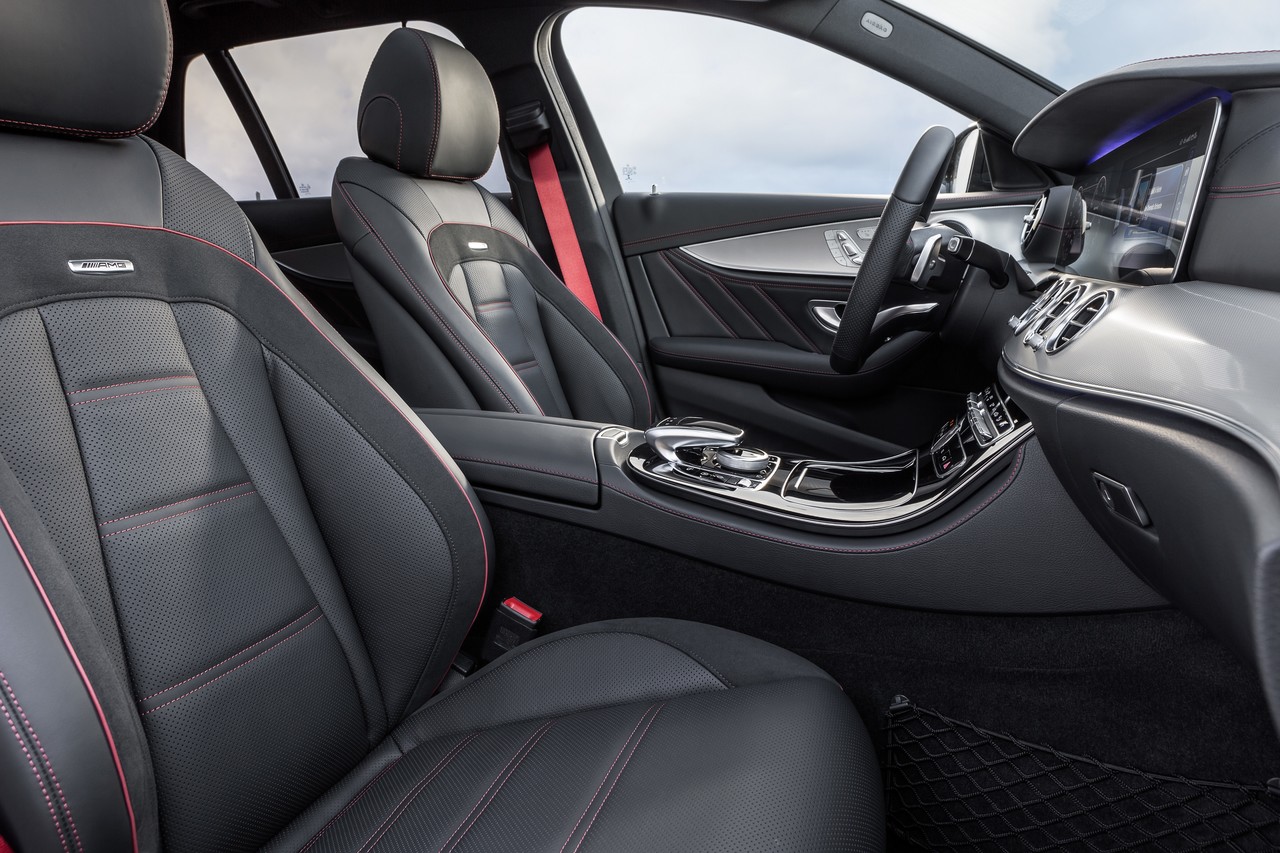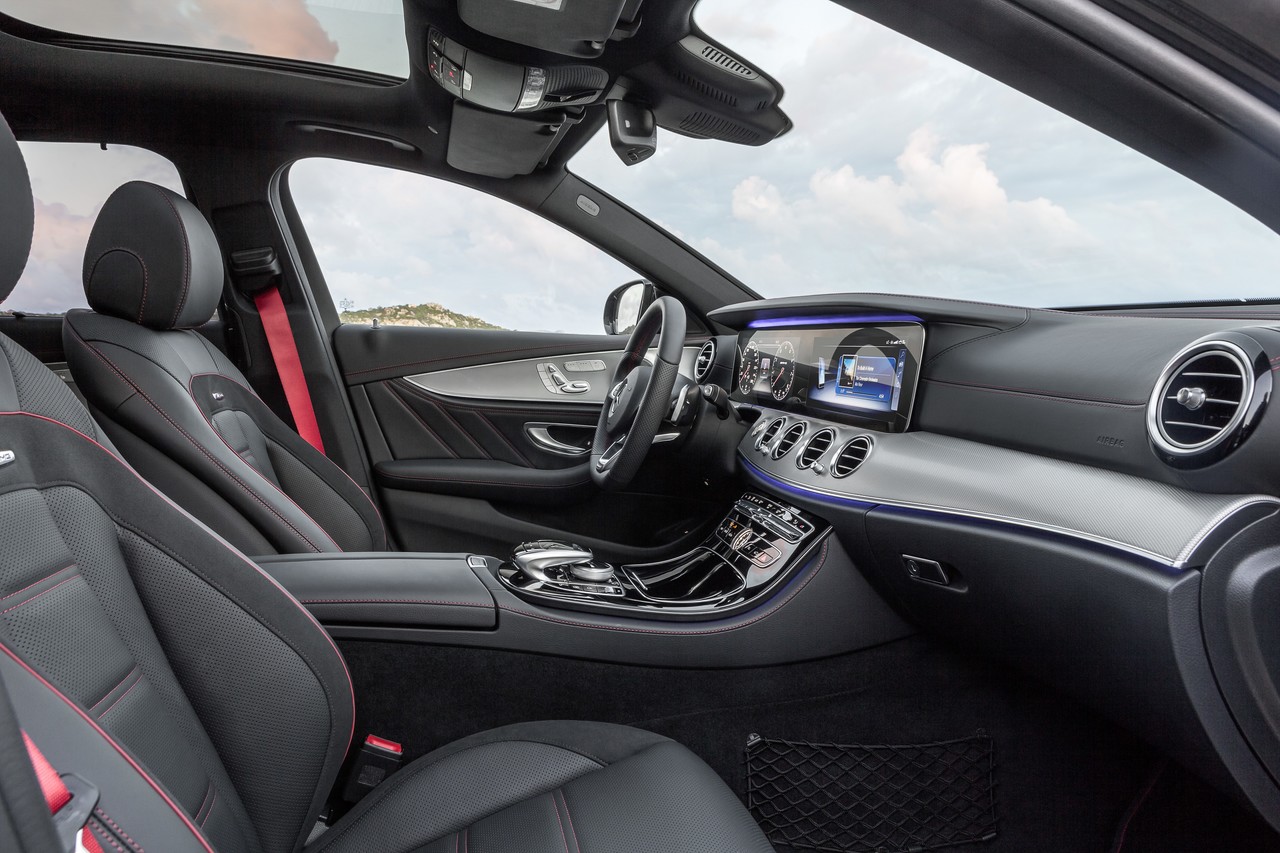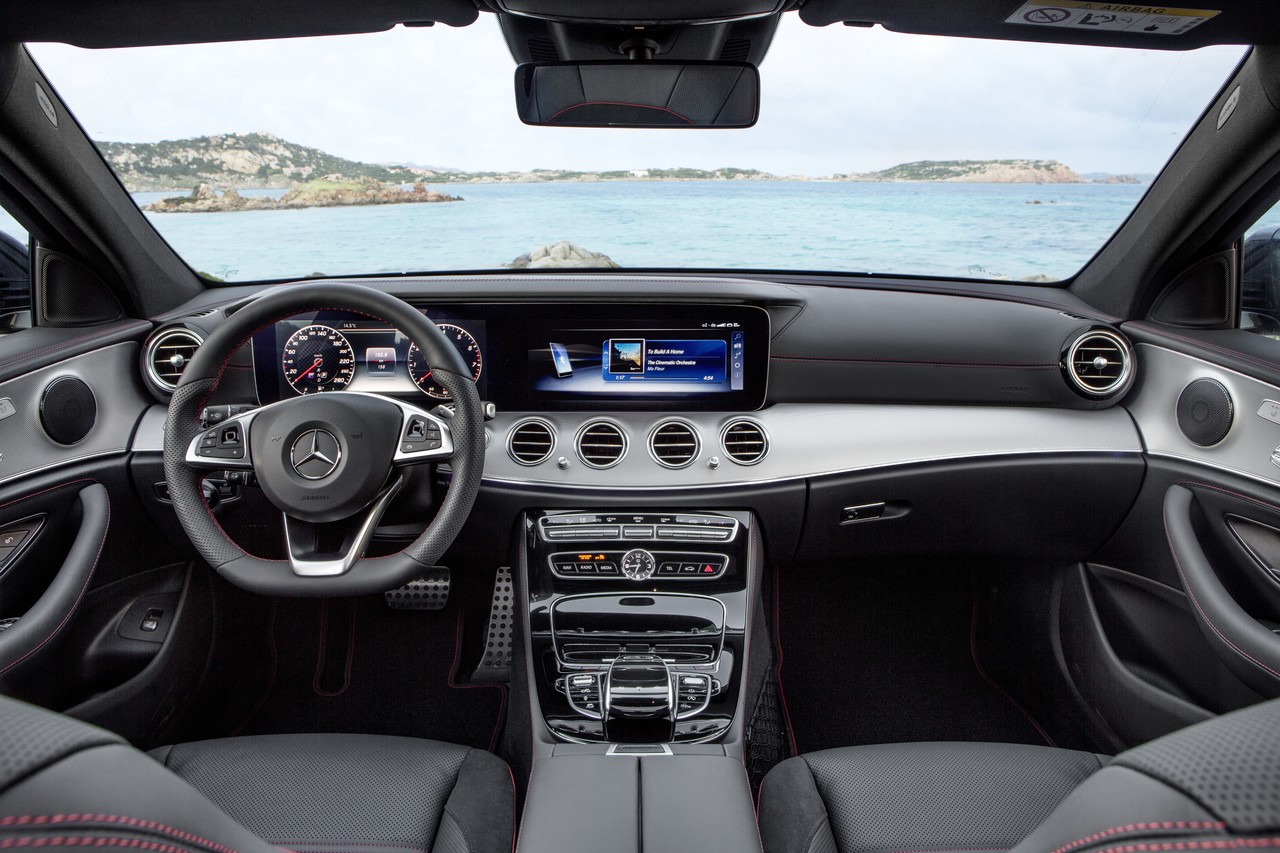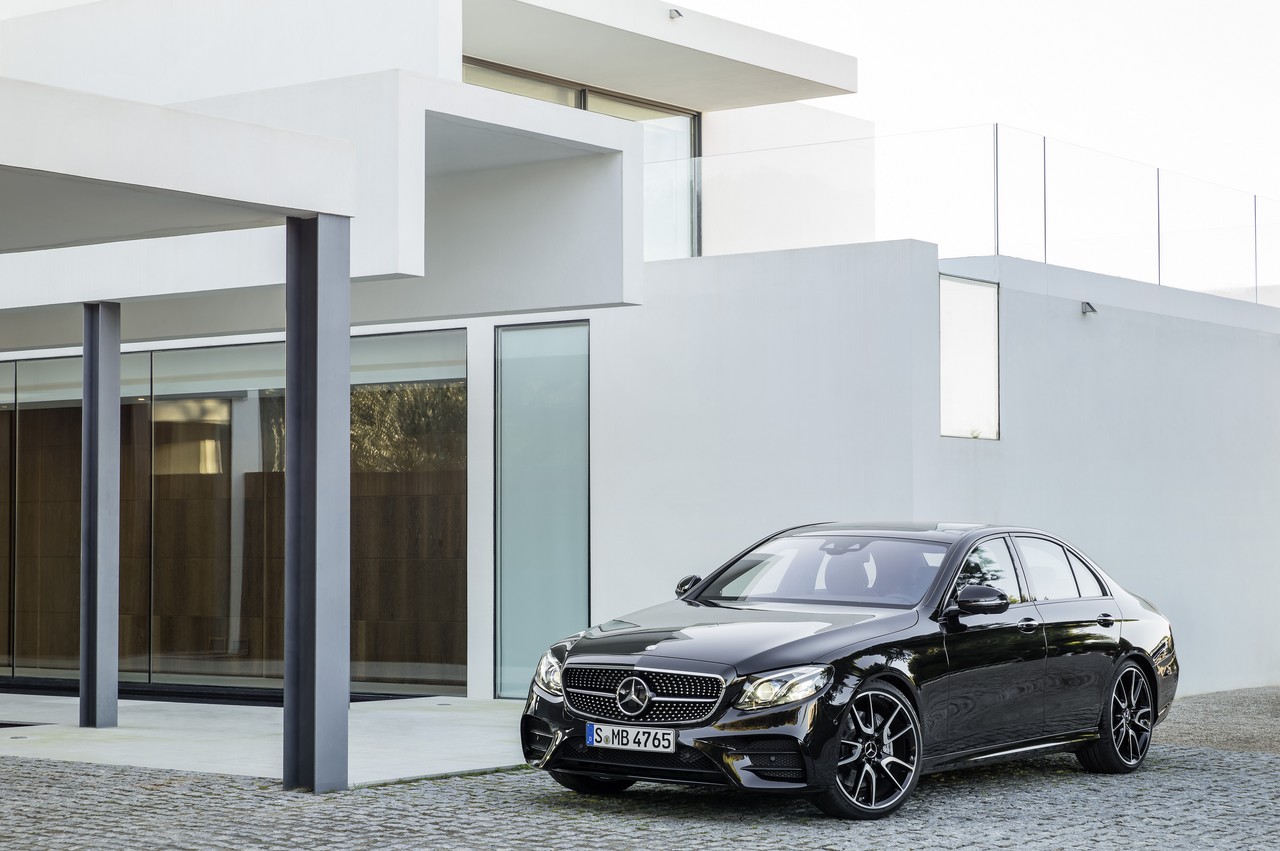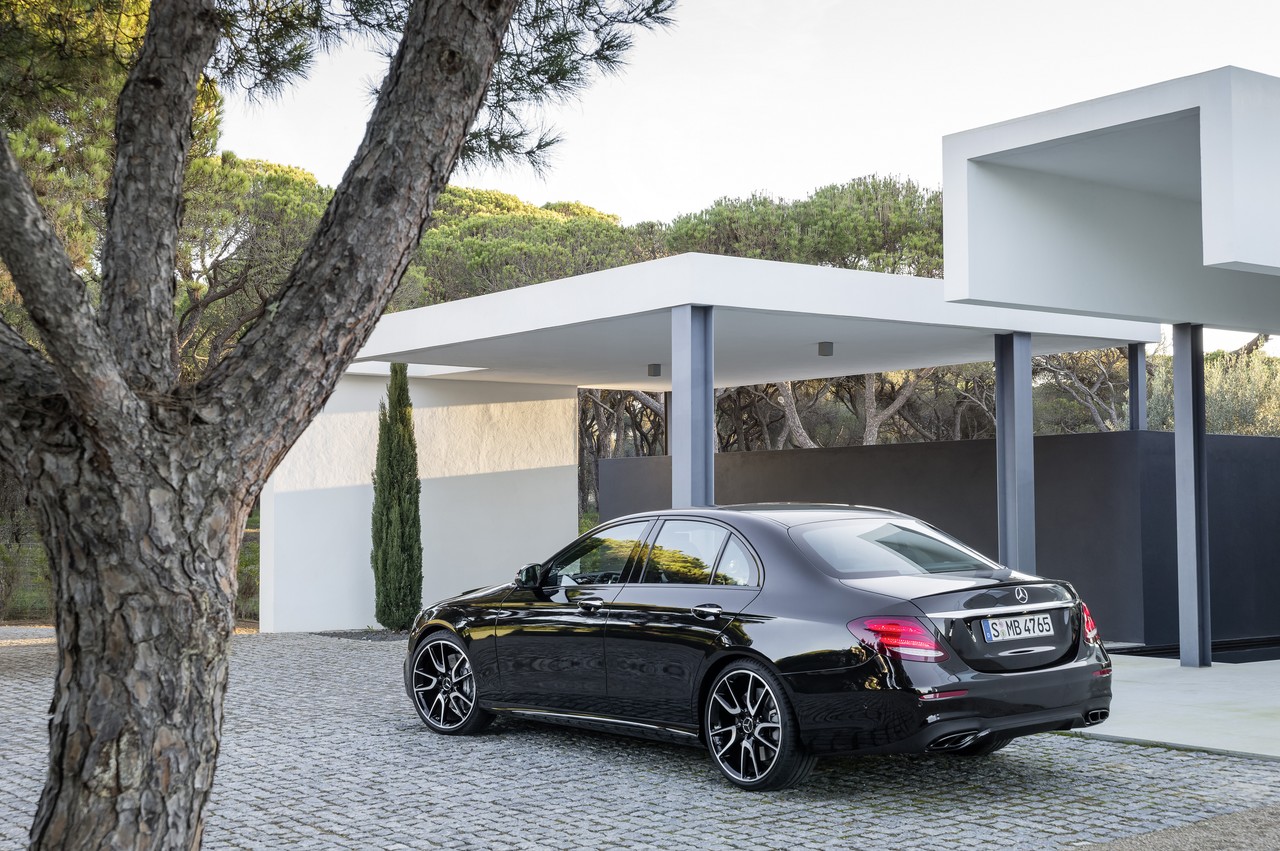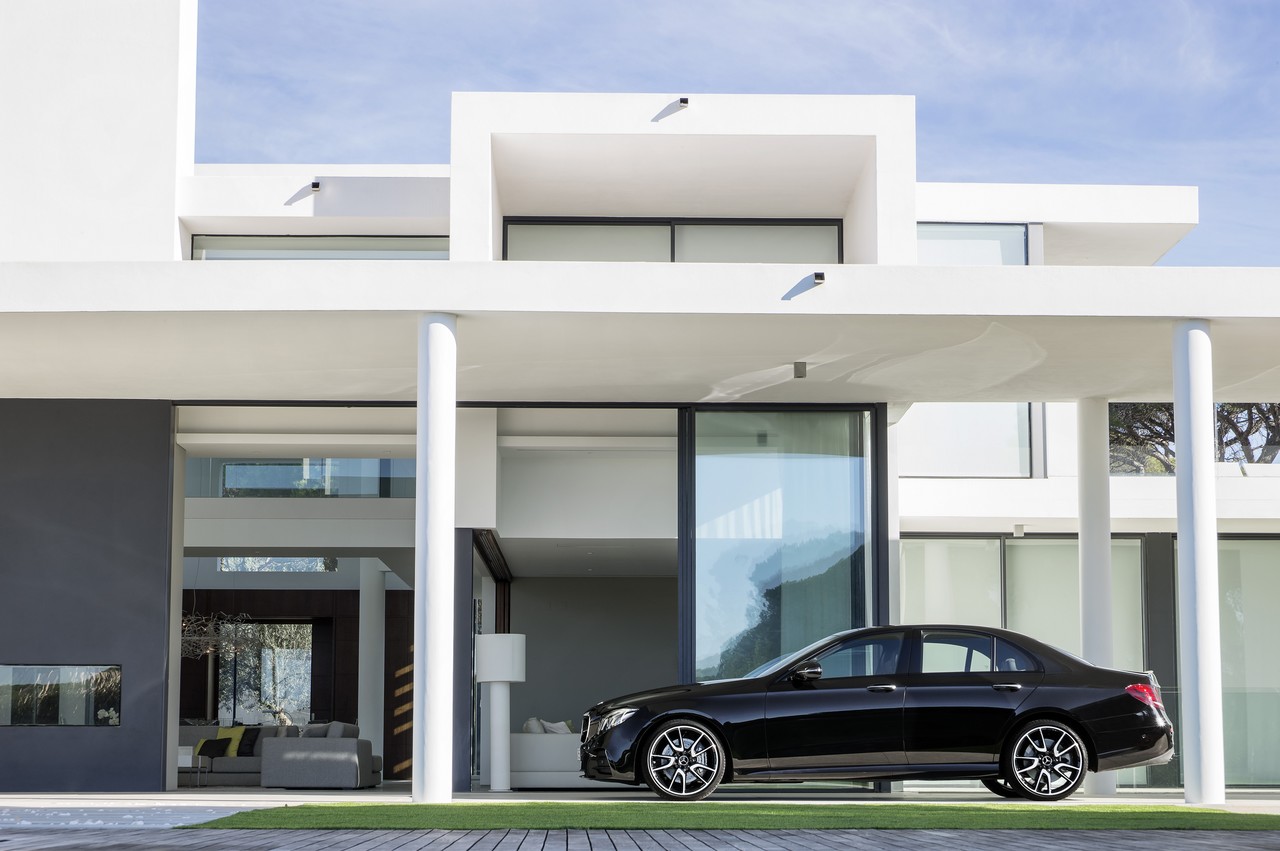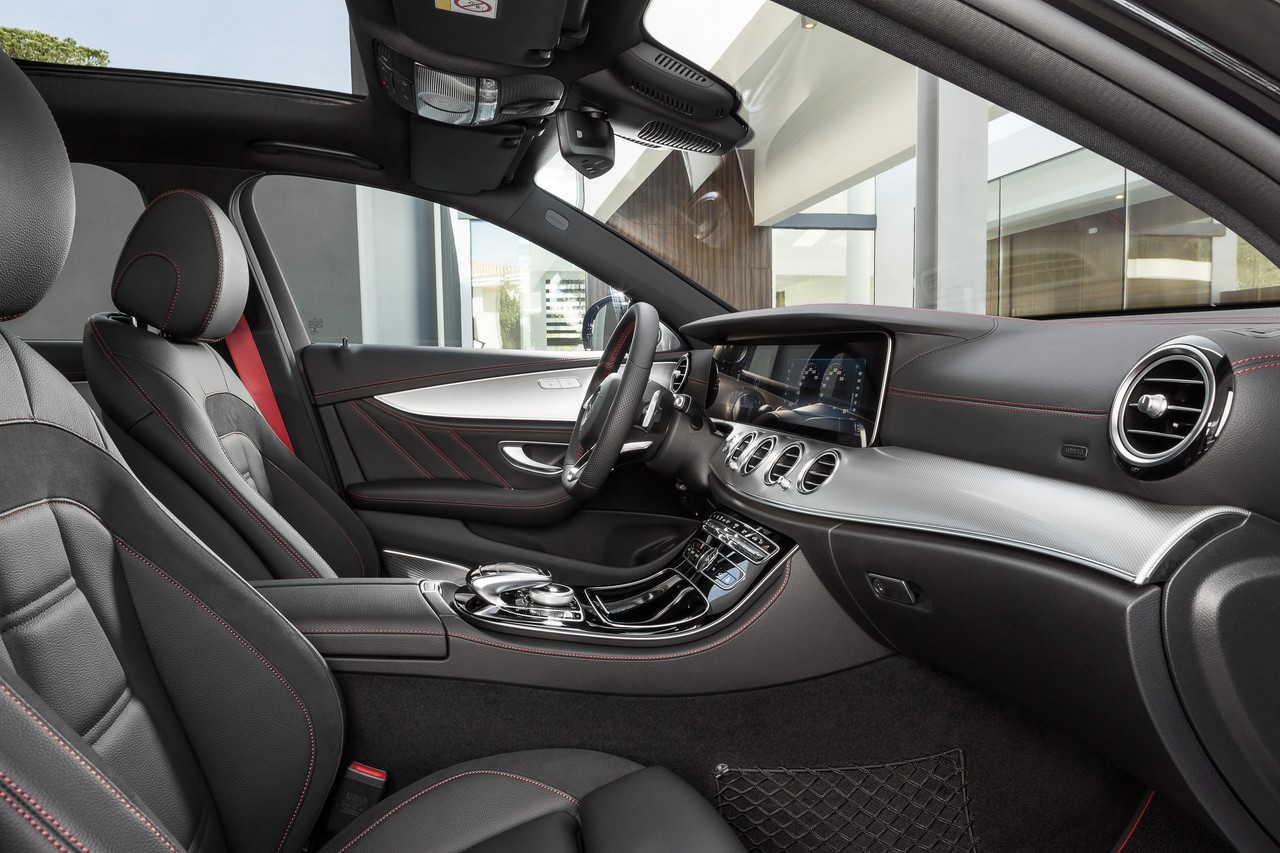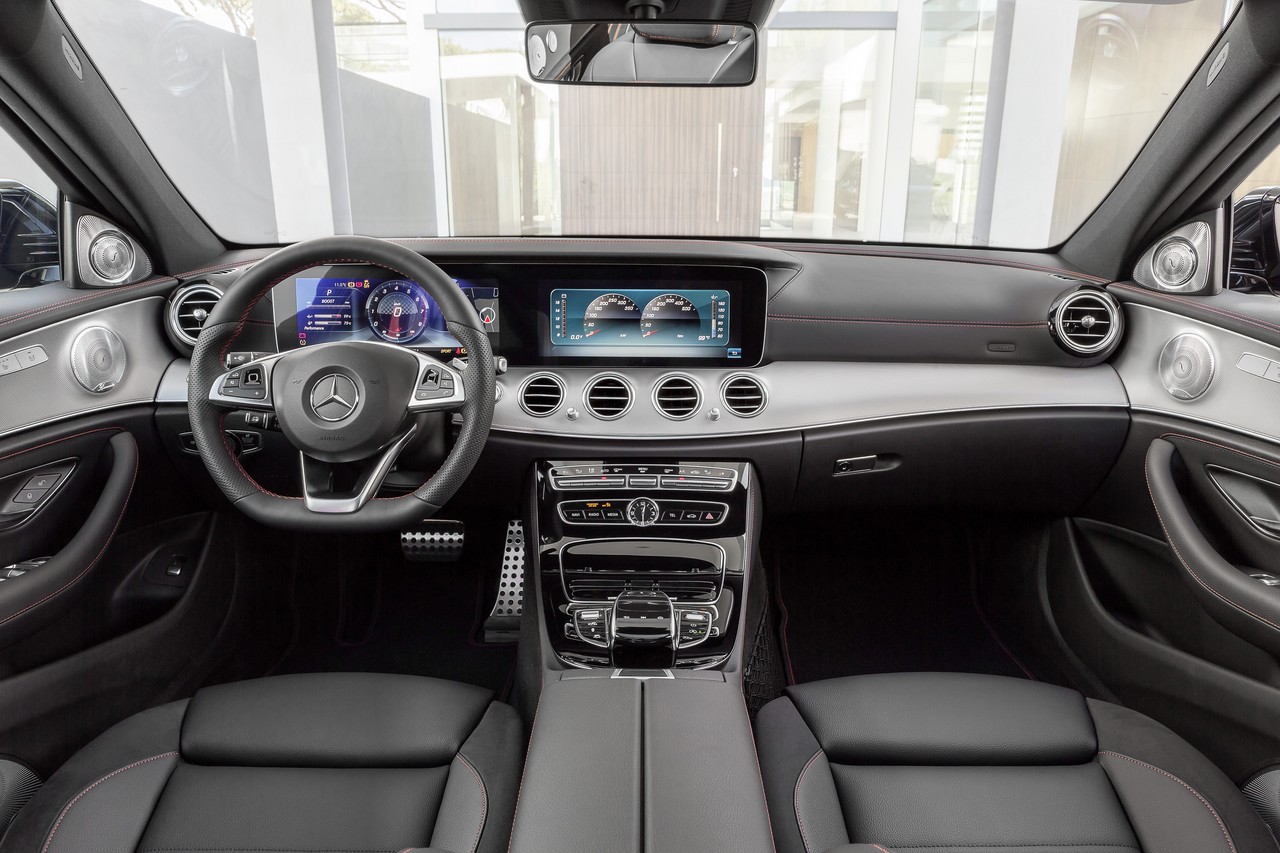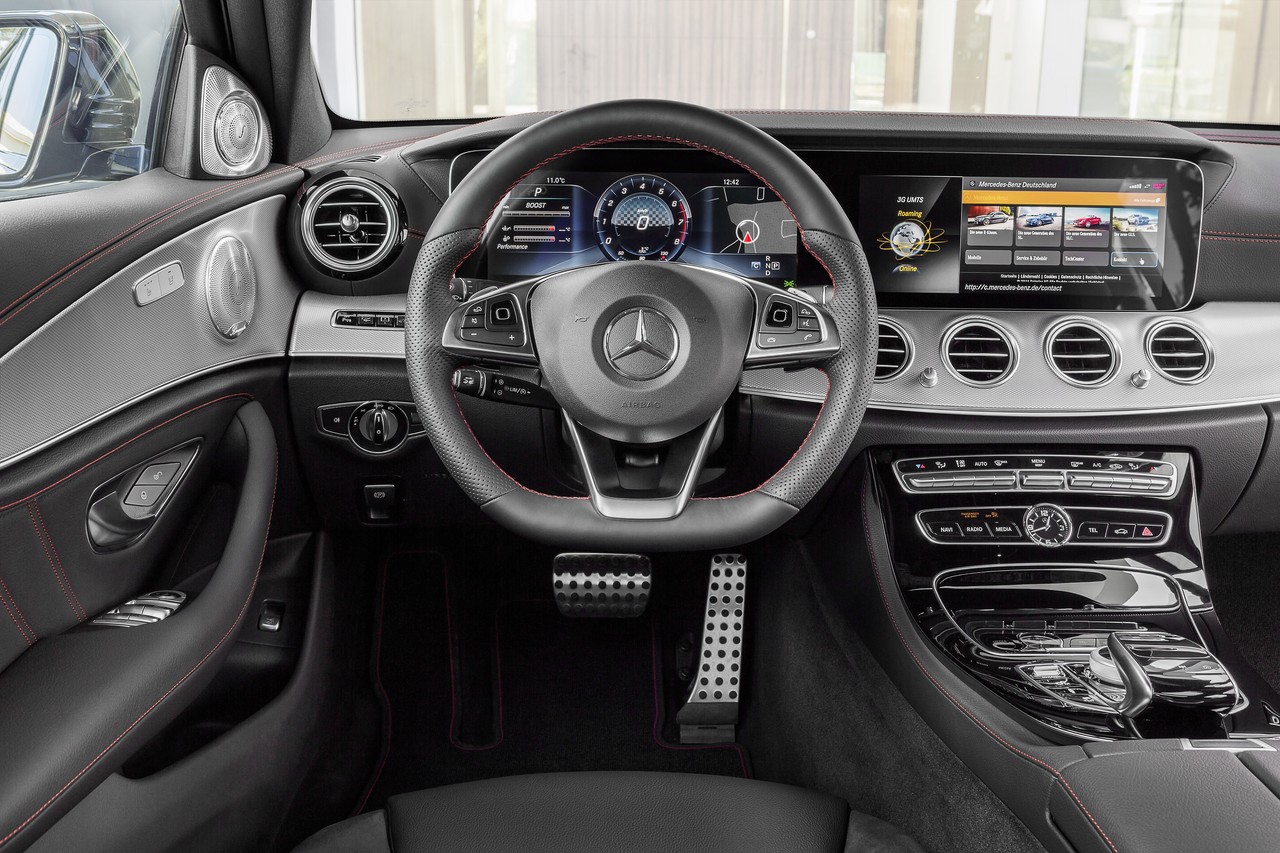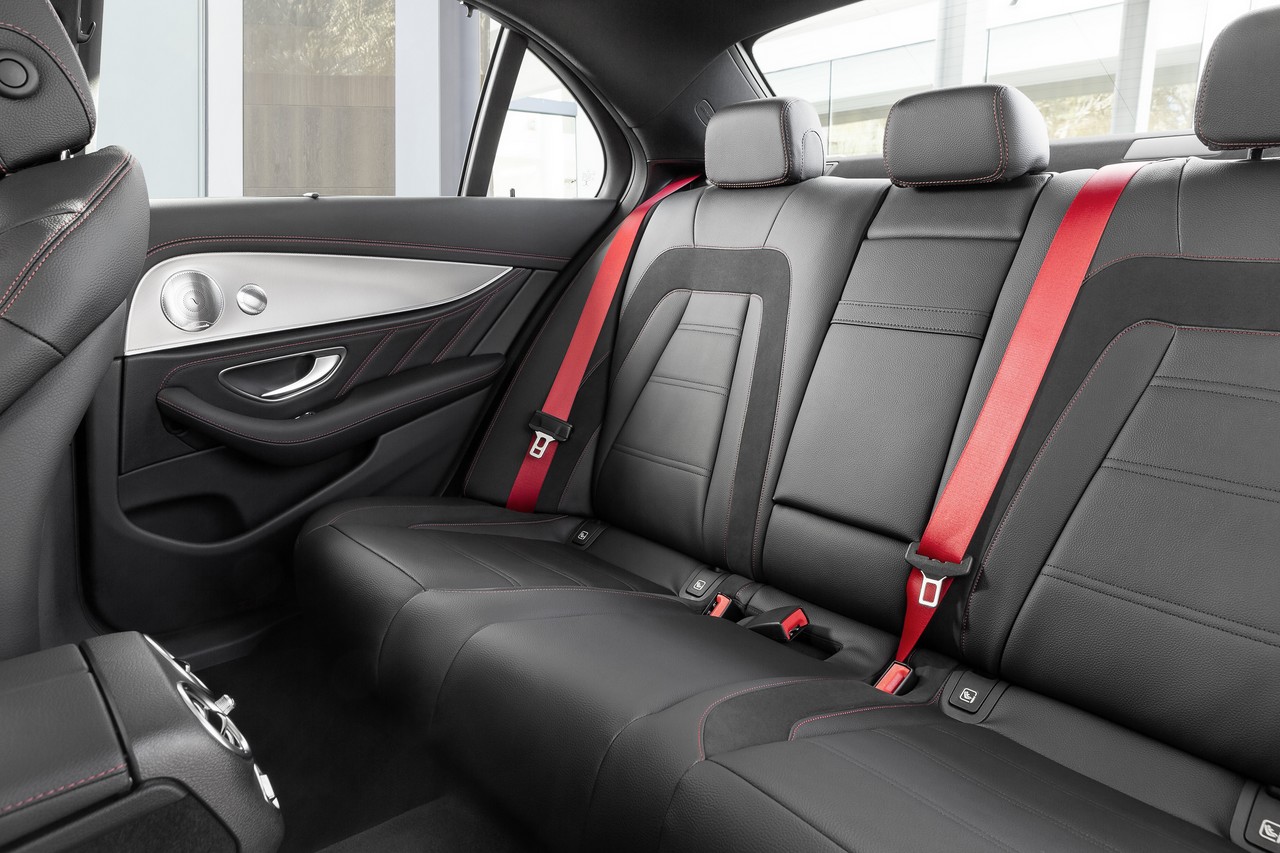
- Steering feedback?
- Less rear seat space than Audi C7 A6
- Surprisingly high kerb weights
Overview
The Mercedes-AMG W213 E 43 was released in Australia in February 2017, with the E 63 and E 63 S following in June 2017. Manufactured in Sindelfingen, Germany, the all-wheel drive Mercedes-AMG W213 E 43 and E 63 were powered by 3.0-litre biturbo V6 petrol and 4.0-litre biturbo V8 petrol engines, respectively. In September 2018, the Mercedes-AMG W213 E 53 was released.
Mercedes-AMG E 43: M276.823 biturbo V6 engine
The Mercedes-AMG E 43 was powered by the M276.823 V6 engine which had an aluminium alloy cylinder block with ‘Nanoslide’ coating for the cylinder liners, a forged steel crankshaft, an aluminium alloy cylinder head, chain-driven double overhead camshafts, independent intake and exhaust camshaft adjustment, four valves per cylinder, a variable-resonance intake manifold, direct injection via piezo injectors which provided injection pressure of up to 200 bar, and a compression ratio of 10.7:1. For the E 43, the M276 engine was fitted with two turbochargers that provided relative charge pressure of 1.1 bar (15.95 psi).
To minimise fuel consumption, the M276 engine had:
- An ECO start/stop function that could shut down the engine when the E 43 was stationary in traffic; and,
- In ‘Eco’ mode, a coasting function that could disengage the clutch when driving at speeds between 60 km/h and 160 km/h to decouple the engine from the powertrain – this eliminated engine braking and electronics could reduce engine speed to idle level.
The Mercedes-AMG E 43 could accelerate from rest to 100 km/h in 4.6 seconds.
Mercedes-AMG E 53 4MATIC+: M256 biturbo I6 engine
For the Mercedes-AMG E 53 4MATIC+, the M256 petrol engine was combined with an ‘EQ Boost’ integrated starter/generator that produced 16 kW and 250 Nm. Using a 48 volt electrical system, EQ Boost could assist the petrol engine when accelerating and enabled the vehicle to coast or ‘sail’ without the operation of the petrol engine. The generator could also supply the battery with power through its energy recuperation function.
Mercedes-AMG E 63: M177.980 biturbo V8 engine
Shared with the Mercedes-AMG C205 C 63 , the M177.980 V8 engine for the Mercedes-AMG E 63 had a cast aluminium closed-deck block, cylinder bore liners with ‘Nanoslide’ technology, zirconium alloy cylinder heads, two twin-scroll turbochargers mounted within the engine’s ‘V’, double overhead camshafts, variable inlet and exhaust valve timing, four valves per cylinder, direct fuel injection via piezo injectors, a compression ratio of 8.6:1 and dry sump lubrication. For the E 63, maximum charge (boost) pressure for the turbochargers was limited to 1.3 bar; for the E 63 S, however, maximum charge pressure was 1.5 bar. The Mercedes-AMG E 63 and E 63 S could accelerate from rest to 100 km/h in 3.5 and 3.4 seconds, respectively.
To reduce fuel consumption, the M177 engine had an ‘ECO start/stop’ function which enabled it to shut down when the E 63 was stationary in traffic. For the E 63 and E 63 S, the M177 engine introduced a cylinder deactivation system that could deactivate cylinders two, three, five and eight if:
- The driver had selected the ‘Comfort’ transmission drive program;
- Engine speed was between 1000 and 3250 rpm; and,
- The engine was in its partial load range.
The cylinder deactivation system utilised Mercedes’ ‘Camtronic’ valve lift adjustment system and could achieve half-engine operation by shutting off the intake and exhaust valves for particular cylinders – this reduced load-change losses for the deactivated cylinders and increased the efficiency of the operational cylinders.
Like the Mercedes-AMG C190 GT , the E 63 S was fitted with dynamic engine mounts which could adapt their stiffness according to driving conditions and style. As such, softer mounts were used to improve comfort by reducing noise and vibration.
| Engine | Trans. | Peak power | Peak torque | |
|---|---|---|---|---|
| E 43 4MATIC | 2996 cc M276.823 biturbo petrol V6 | 9sp auto | 295 kW at 6100 rpm | 520 Nm at 2500-5000 rpm |
| E 53 AMG 4MATIC+ | 2999 cc M256 biturbo petrol I6 | 9sp auto | 320 kW at 6100 rpm, plus 16 kW electric boost | 520 Nm at 1800-5800 rpm, plus 250 Nm electric boost |
| E 63 4MATIC+ | 3982 cc M177.980 biturbo petrol V8 | 9sp MCT | 420 kW at 5750-6500 rpm | 750 Nm at 2250-5000 rpm |
| E 63 S 4MATIC+ | 3982 cc M177.980 biturbo petrol V8 | 9sp MCT | 450 kW at 5750-6500 rpm | 850 Nm at 2500-4500 rpm |
Mercedes E 43: 4MATIC all-wheel drive system
For the Mercedes E 43, the permanent all-wheel drive system (Mercedes’ ‘4MATIC’) utilised a single-stage transfer case that was flange-mounted to the 9G-Tronic transmission as a separate system. For the Mercedes E 43, the system provides a front:rear torque split of 31:69.
Mercedes E 63: 4MATIC+ all-wheel drive system and AMG Speedshift MCT
For the Mercedes E 63, the ‘4MATIC+’ permanent all-wheel drive system utilised an electromechanically controlled coupling to connect the permanently driven rear axle to the front axle. According to Mercedes,
- The optimum front:rear torque distribution was continuously calculated according to the driving conditions and driver’s input; and,
- The torque distribution for the front and rear axles was fully variable.
The Mercedes E 63 S had a drift mode which could be activated in the ‘Race’ drive program; the ‘Race’ program deactivated the electronic stability control system and, in drift mode, the E 63 S was solely driven by the rear wheels.
The nine-speed ‘AMG Speedshift MCT’ (Multi Clutch Technology) had multiple clutches that were placed together and controlled separately. The AMG Speedshift MCT had a compact, wet start-up clutch that operated in an oil bath rather than a conventional torque converter and unlike, double clutch transmissions, had a single input shaft. Features of the AMG Speedshift transmission included:
- Automatic throttle-blipping on downshifts;
- A double-declutching function for multiple downshifts; and,
- A ‘Race Start’ function.
For the W213 E 63, the Speedshift MCT introduced a ‘gliding mode’. When the driver released the accelerator at speeds between 60 km/h and 160 km/h, the clutch of the MCT would open to decouple the engine from the powertrain. Furthermore, electronics would reduce engine speed to idling level and motion resistance was reduced by the compression and frictional forces of the engine in overrun mode.
Body and dimensions
Compared to the Mercedes-Benz W212 E 63 AMG , the Mercedes-AMG E 63 was 97 mm longer (at 4988 mm), 35 mm wider (1907 mm), 18 mm taller (1460 mm) and had a 65 mm longer wheelbase (2939 mm); its boot capacity was 540 litres. Relative to the W213 E 63, however, the W213 E 43 was 41 mm shorter (at 4947 mm), 55 mm narrower (1852 mm) and 13 mm lower (1447 mm).
According to Mercedes-Benz, the body of the W213 E-Class has ‘a far higher proportion of aluminium and ultra-high-strength steel components’ than the W212 E-Class. To minimise mass, the front wings, bonnet, boot lid and large sections of the front and rear ends were made of sheet or cast aluminium. The Mercedes-AMG E 63, however, differed from the E 43 in that it had two additional rear struts to reinforce the bodyshell.
The Mercedes-AMG E 43 and E 63 had kerb weights of 1840 kg and 1950 kg, respectively (EC method, fuel tank at 90 per cent full and 75 kg driver).
‘AMG Ride Control’ suspension
The Mercedes-AMG E 43 had a three-link front axle with twin-tube gas-filled shock absorbers and a multi-link rear axle with single-tube gas-filled shock absorbers. The suspension included Mercedes’ ‘Air Body Control’ multi-chamber air suspension which consisted of:
- Two chambers of different sizes in the spring struts of the front axle; and,
- Three chambers of different sizes in the spring struts of the rear axle.
The Air Body Control suspension adjusted, in three stages, how stiffly the suspension reacted; the driver could also pre-select damping characteristics from Comfort, Sport and Sport Plus modes. Furthermore, Air Body Control suspension included a continuously operating, electronically controlled damping adjustment system which adjusted damping at each individual wheel according to the driving situation (including evasive manoeuvres) and road conditions.
Compared to the Mercedes-Benz W213 E-Class , the Mercedes-AMG E 43 and E 63 had:
- Special steering knuckles and load-bearing joints for the front axle;
- Additional negative camber (for front and rear axles) to enhance cornering ability; and,
- Higher spring rates to reduce body roll.
Pneumatic self-levelling for the front and rear axles enabled the E 43 and E 63 to maintain a constant ride height regardless of load, while the driver could press a button to increase ground clearance.
The suspension for the Mercedes-AMG W213 E 63 differed from the E 43 in that it had:
- A four-link front axle (not three-link);
- A re-engineered rear axle; and,
- A tubular rear anti-roll bar.
Steering
The Mercedes-AMG W213 E 43 and E 63 had electromechanical speed-sensitive sports steering with a variable ratio. While the turning circle was 12.5 metres, the steering ratio at dead centre was understood to differ at 14.5:1 for the E 43 and 15.5:1 for the E 63. Furthermore, the driver could vary the level of power assistance by selecting from the Comfort, Sport or Sport Plus (for the E 63 and E 63 S) drive modes.
Safety equipment
Standard safety equipment for the Mercedes-AMG W213 E 43 and E 63 included dual front airbags, a driver’s knee airbag, front and rear side airbags, full-length curtain airbags, ABS, electronic brake force distribution, brake assist, electronic stability control, traction control and front seatbelts with pre-tensioners and load limiters.
As standard, Australian-delivered Mercedes-AMG W213 E 43 and E 63 vehicles were fitted with a ‘Driving Assistance package Plus’ which included:
- Drive Pilot: operated at speeds up to 210 km/h and could control the distance from the vehicle ahead, vehicle speed and steering via the following functions:
- Distance Pilot Distronic: adaptive cruise control that could maintain a safe distance from a vehicle ahead at speeds of up to 210 km/h and in stop/start traffic. An extended restart function also enabled automatic starting of the vehicle within 30 seconds after a stop that was initiated by Distance Pilot Distronic;
- Steering Pilot: used a camera to detect road markings and vehicles ahead so that Steering Pilot could follow vehicles ahead even on roads with several lanes or unclear road markings. Steering Pilot could also provide steering assistance for ‘moderate bends’;
- Active Emergency Stop Assist: if the driver removed their hands from the steering wheel, warnings would be issued that directed the driver to grip the steering wheel. If the driver did not respond, Active Emergency Stop Assist could bring the vehicle to a standstill within its lane;
- Active Lane Change Assist: a radar- and camera-based system which assisted the driver when changing lanes on multi-lane roads and could steer the vehicle into the lane selected by the driver. Once the driver had indicated to turn for at least two seconds, Active Lane Change Assist would steer the vehicle into the adjacent lane if it detected that the lane was unoccupied;
- Active Brake Assist with cross-traffic function: extended speed thresholds for autonomous braking (‘Active Brake Assist’) for vehicles and pedestrians. The cross-traffic function could detect crossing traffic at junctions and, in hazardous situations, could apply the brakes autonomously. Furthermore, it could detect hazardous situations at the tail-end of traffic jams (where there was no room to manoeuvre) and initiate autonomous braking far sooner. Consequently, it was possible to avoid accidents at speeds up to 100 km/h or substantially reduce the severity of accidents at speeds above this level;
- Evasive Steering Assist: complemented the pedestrian detection function of Active Brake Assist. When the driver deliberately or instinctively performed an evasive manoeuvre in a dangerous situation, this function could assist by adding ‘precisely calculated steering torque’ to support the movement of the steering wheel – this helped the driver to avoid the pedestrian in a controlled manner while helping to ‘straighten up’ the vehicle afterwards;
- Active Blind Spot Assist: active at speeds above 60 km/h, a corrective braking force was applied to the wheels on one side of the vehicle if the driver attempted to change lanes when a vehicle was detected in the driver’s blind spot;
- Active Lane Keeping Assist: initiated steering wheel vibrations if the vehicle approached a continuous lane marking line and, if crossed, automatically braked wheels on one side of the vehicle to return the vehicle within the lane;
- Pre-Safe Plus: could anticipate rear-end collisions and warn following traffic by flashing the rear hazard warning lights at high frequency;
- Pre-Safe Impulse Side: if a lateral collision was imminent, Pre-Safe impulse side moved the driver or front passenger laterally away from the danger zone by inflating an air chamber in the side bolster of the front seat backrest nearest the side of the imminent impact – this increased the distance between occupant and door, thereby reducing the forces acting on the occupants;
- Attention Assist with adjustable sensitivity: operated at speeds in excess of 80 km/h and monitored driver behaviour and steering movements for signs of drowsiness; if detected, the driver was provided with visual and audible warnings; and,
- Crosswind Assist: could detect sudden, strong gusts of wind and prevent the vehicle from drifting out of its lane via corrective braking forces on one side of the vehicle.
The Mercedes-AMG W213 E-Class was fitted with an ‘active bonnet’ which, in the event of a pedestrian collision, triggered a pyrotechnic charge to raise the height of the bonnet and provide additional clearance to ‘hard points’ within the engine bay.
From September 2018, the Mercedes-AMG W213 E-Class was equipped with Traffic Sign Assist (TSA) which used navigation data and image recognition to display – in the instrument cluster – the maximum permitted speed, restrictions on overtaking and pedestrian warnings near ‘zebra’ crossings. Traffic Sign Assist also had an extended wrong-way warning, while the detection of stop signs was combined with the ECO start/stop function so that the engine remained on. Furthermore, Active Speed Limit Assist was a sub-function of Traffic Sign Assist that used the forward-facing camera to recognise sign gantries and road works signs to set the vehicle’s maximum speed.
Euro NCAP testing
In Euro NCAP testing , the Mercedes-Benz W213 E-Class Sedan received a five star safety rating which included a 95 per cent adult occupant protection rating and a 90 per cent child occupant protection rating. In the frontal offset test, protection of the driver’s head, thighs and feet were rated as good, though chest and lower leg protection were rated as adequate (i.e. a slight risk of serious injury). Maximum points were awarded in the side impact test; in the more severe pole test, however, chest protection for the driver was rated as adequate.
Wheels, tyres and brakes
For Australian-delivered vehicles, the Mercedes-AMG E 43 was fitted with 8.0J x 20-inch front and 9.0J x 20-inch rear five twin-spoke silver/black alloy wheels, 245/35 ZR20 front and 275/30 ZR20 rear tyres. Furthermore, the E 43 had 360 mm by 36 mm cross-drilled and vented front brake discs with four-piston fixed callipers and 360 mm by 26 mm cross-drilled and vented rear discs with single-piston floating callipers.
The Mercedes-AMG E 63 was fitted with 360 mm by 36 mm cross-drilled and vented front brake discs with six-piston fixed callipers and 360 mm by 24 mm cross-drilled and vented rear discs with single-piston floating callipers. The Mercedes-AMG E 63 S, however, had 390 mm by 36 mm cross-drilled and vented front brake discs.
The Mercedes-AMG E 63 could also be specified with an optional, extra-cost ‘AMG Carbon Ceramic’ braking system which consisted of 402 mm by 39 mm front and 360 mm by 32 mm rear discs.
Features: Mercedes-AMG E 43
As standard, the Mercedes-AMG W213 E 43 was equipped with the COMAND Online Infotai Nment system which included a high-resolution display, digital radio tuner (DAB+), HDD navigation with 3D maps and dynamic route guidance, internet connectivity, smartphone integration via Android Auto or Apple CarPlay.
Standard features for the Mercedes-AMG W213 E 43 included a 590 watt Burmester surround sound system with thirteen speakers and a nine-channel digital sound processing (DSP) amplifier, ‘Thermatic’ dual-zone climate control air conditioning with pre-entry function and ‘Air-Balance’ perfume and ionisation package, Nappa leather upholstery, power adjustable front sports seats, heated front seats, rain-sensing wipers, a head-up display with virtual image windscreen projection, a flat-bottomed sports steering wheel with gearshift paddles, 40:20:40 split-folding rear seat backrests, remote central locking with proximity key, power adjustable and heated door mirrors with folding function, power windows, a power adjustable steering wheel (for height and reach), memory settings (for the front seats and door mirrors), an auto-dimming rear-view mirror, push-button start, ambient interior lighting, an analogue clock, velour floor mats, synthetic leather upholstery for the upper dashboard, a black roof liner, a 12 volt power socket, AMG sports pedals, rear privacy glass, a panoramic glass sunroof with roller sunblind, tyre pressure monitoring, a trip computer, an alarm with tow-away protection and an immobiliser.
As standard, the Mercedes-AMG E 43 was also equipped with:
- Multi-beam LED headlights which consisted of 84 individually controlled LEDs and enabled the light distribution from the headlights to be controlled separately to avoid dazzling other road users;
- A rear view camera with dynamic guidelines;
- A 360 degree camera system which provided a bird’s eye view of the vehicle on the centre display and dynamic guidelines; and,
- Parking Pilot with Parking Assist: automatically engaged when driving at speeds up to 30 km/h, Parking Pilot could identify parallel and right angle parking spaces. Furthermore, the Parking Assist function could provide automated steering to manoeuvre the vehicle into the space while the driver controlled vehicle speed.
Features: Mercedes-AMG E 63 and E 63 S
Compared to the E 43, the Mercedes-AMG E 63 was further equipped with 20-inch five-twin-spoke alloy wheels, three-zone climate control air conditioning (‘Thermotronic’), and an IWC-designed analogue clock.
The Mercedes-AMG E 63 S was distinguished by its 20-inch forged alloy wheels finished in matt black, digital TV tuner, AMG Performance seats, AMG Performance steering wheel in nappa leather and ‘Dinamica’ microfibre, a Nappa leather covering for the instrument panel and beltlines, and wireless mobile phone charging. Visual cues for the E 63 S included the AMG Night Package styling and red-painted brake calipers.
Rear differential locks
While the Mercedes-AMG E 63 was fitted with a mechanical rear differential lock as standard, the E 63 S had an electronically controlled rear differential lock. Both differentials had the same function: to reduce slip on the inside rear wheel when cornering without control interventions in the braking system. According to Mercedes, however, the electronic limited slip differential (LSD) was more sensitive and provided proactive control. For greater cooling, the housing of the electronic LSD had additional cooling fins.
2017 Mercedes-AMG E 63 S Edition 1
To coincide with the release of the Mercedes-AMG E 63, an ‘Edition 1’ package was available for the E 63 S which included ‘designo’ selenite grey magno paintwork, an AMG high-performance ceramic composite braking system, AMG side sports decals in matt graphite, yellow topstitching for the black ‘AMG Exclusive’ nappa leather seats and steering wheel, and carbon fibre trim.
Mercedes-AMG W213 E 53
Released in Australia in September 2018, standard features for Mercedes-AMG E 53 included 20-inch five twin-spoke alloy wheels, Burmester surround sound system, nappa leather upholstery, front sports seats, a panoramic glass sunroof, AMG Performance exhaust system and AMG exterior styling (including a bootlip spoiler). For the complete list of features, please refer to the specifications document, below.
Brochure and specifications
- Brochure: Mercedes-Benz W213 E-Class Sedan (July 2016)
- Specifications: Mercedes-Benz W213 E-Class Sedan (November 2016)
- Specifications: Mercedes-Benz W213 E-Class Sedan (July 2018)
